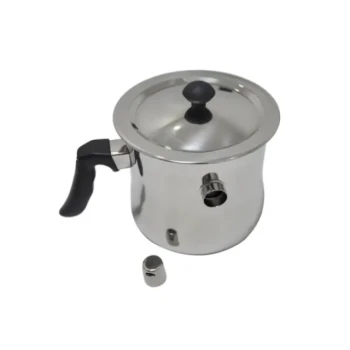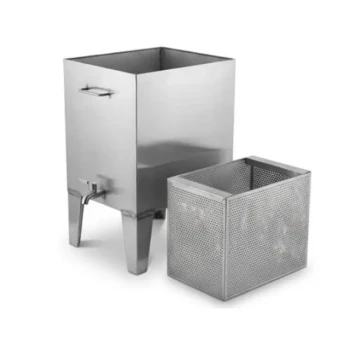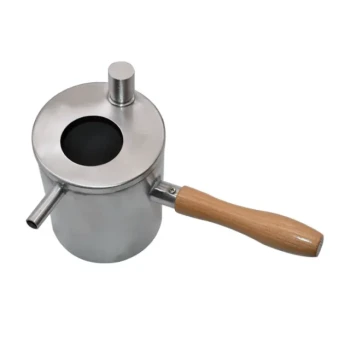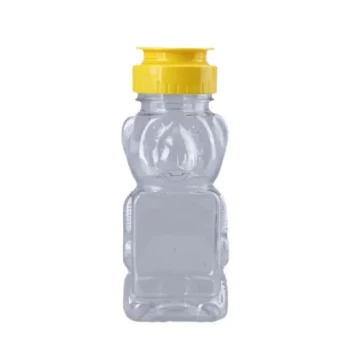To remove crystallized honey from frames, you must either gently warm the frames until the honey re-liquefies for standard extraction, or choose a method that sacrifices either the honey or the comb. Soaking the frames in water will dissolve the honey but save the comb for the bees, while the crush-and-strain method saves the honey but destroys the comb.
Crystallized honey, also known as granulation, makes standard centrifugal extraction impossible. Your choice of removal method hinges on a critical decision: do you prioritize saving the valuable honey harvest or the bees' meticulously built wax comb?
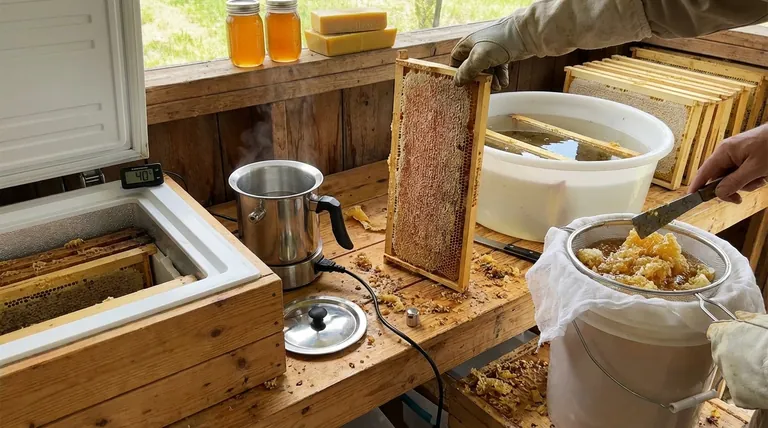
Why Standard Extraction Fails
The Physics of Crystallization
Honey is a supersaturated solution of sugars, primarily glucose and fructose. Over time, the glucose can precipitate out of the solution, forming solid crystals.
Once honey has granulated within the comb's cells, it becomes a semi-solid mass. The centrifugal force generated by a honey extractor is not strong enough to overcome this solid structure and pull the honey from the cells.
The Role of Nectar Source
Crystallization speed is heavily dependent on the nectar source. Nectars with a higher glucose-to-fructose ratio, such as those from clover, canola, aster, and dandelion, will crystallize much more rapidly than those with higher fructose levels, like tupelo or acacia.
Method 1: Warming the Frames to Save Honey and Comb
This is the ideal method if your goal is to salvage both the honey for consumption and the drawn comb for your bees.
The Principle: Re-liquefying Crystals
Gentle, consistent heat will melt the glucose crystals, returning the honey to a liquid state without damaging its delicate enzymes or melting the beeswax comb.
Creating a Warming Cabinet
You can easily construct a "hot box" for this purpose. An old refrigerator or a large, insulated cooler works perfectly. Place a low-wattage heat source, like a 60-watt incandescent bulb on a dimmer or a small heating pad, at the bottom.
Place the frames inside, ensuring they don't directly touch the heat source. Use a thermometer to monitor the internal temperature.
Critical Temperature Control
The key to this method is precise temperature. Maintain a consistent temperature between 95°F and 115°F (35°C and 45°C).
Temperatures below this range may not be effective, while temperatures above 120°F (49°C) risk melting the beeswax comb and degrading the quality of the honey.
The Uncap, Warm, and Extract Process
First, use an uncapping tool like a knife or scratcher to open the capped cells. Then, place the frames in your pre-heated warming cabinet for 24 to 48 hours.
Once the honey is fully liquid again, immediately transfer the warm frames to your extractor. The warm, fluid honey will spin out easily.
Understanding the Trade-offs
If building a warming cabinet isn't feasible, you must choose what to sacrifice.
Trade-off 1: Sacrifice the Honey to Save the Comb
Drawn comb is an incredibly valuable resource for a beehive, saving the bees thousands of hours of work.
To save the comb, uncap the frames and submerge them in a tub of warm (not hot) water overnight. The water will dissolve the crystallized honey. The frames can then be rinsed and dried, or given back to the bees to clean and refill. The resulting honey-water solution is too diluted for human use but can be used to feed bees.
Trade-off 2: Sacrifice the Comb to Save the Honey
If you must save the honey and cannot warm the frames, you will have to destroy the comb.
Use a hive tool to scrape all the wax and crystallized honey from the frames into a large food-grade bucket. Gently heat this mixture in a double boiler until the honey is liquid. Then, pour the mixture through a series of progressively finer strainers or cheesecloth to separate the liquid honey from the pieces of wax.
Making the Right Choice for Your Goal
Your decision depends entirely on your immediate priorities as a beekeeper.
- If your primary focus is a high-quality honey harvest: Build a warming cabinet. This is the only method that preserves both the honey's quality and the valuable comb.
- If your primary focus is strengthening your colony for next season: Sacrifice the honey by soaking the frames. Giving the bees clean, empty drawn comb provides a massive head start.
- If you have limited equipment and must save the honey: Use the crush and strain method, but be prepared to render the leftover wax and provide your bees with new foundation.
By understanding these distinct methods and their outcomes, you can confidently manage crystallized honey and protect the resources that matter most to your apiary.
Summary Table:
| Method | Goal | Outcome for Honey | Outcome for Comb |
|---|---|---|---|
| Warming Frames | Save Both | Harvested for consumption | Reusable by bees |
| Soaking in Water | Save the Comb | Lost (bee feed only) | Cleaned and reusable |
| Crush and Strain | Save the Honey | Harvested for consumption | Destroyed |
Reclaim Your Harvest with the Right Equipment
Struggling with crystallized honey highlights the need for reliable, high-quality beekeeping supplies. At HONESTBEE, we understand the challenges faced by commercial apiaries and distributors. We supply the durable, efficient equipment you need to manage your harvests effectively, from robust extractors to foundation frames.
Let us help you protect your valuable resources.
Contact our wholesale team today to discuss your apiary's needs and explore our product catalog.
Visual Guide

Related Products
- Beeswax Melter for Candle Making Honey Bee Wax Melter
- 10L Stainless Steel Electric Honey Press Machine
- Steam Beeswax Melter Wax Warmer for Wax Processing
- HONESTBEE 72 Frame Industrial Electric Honey Extractor for Beekeeping
- 8-Frame Electric Self-Reversing Honey Extractor Spinner for Commercial Honey Extraction Equipment
People Also Ask
- How do water jacket melters function? Achieve Gentle, Scorch-Free Melting for Sensitive Materials
- How does a steam wax melter work? A Fast, Efficient Method for High-Quality Wax
- What are the benefits of using a professional wax melter? Achieve Consistent, Scalable, and Safe Production
- What do you use a wax melter for? From Home Fragrance to Professional Beekeeping
- What is the recommended temperature range for melting beeswax? Achieve Perfect Quality & Safety
